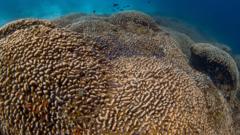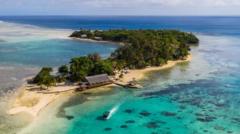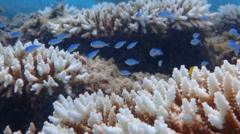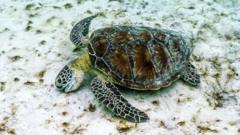Scientists discover the largest coral known to exist, raising awareness for ocean preservation amid climate challenges.
**Ancient Giant Coral Discovered in Southwest Pacific**

**Ancient Giant Coral Discovered in Southwest Pacific**
A breathtaking find of a colossal coral unveils the impact of climate change on marine ecosystems.
The southwestern Pacific Ocean has unveiled a remarkable discovery – the largest coral ever recorded, potentially over 300 years old. This mega coral, identified as a singular massive organism rather than a traditional reef, surpasses even a blue whale in size. It was located by a videographer during a National Geographic expedition aimed at assessing the effects of climate change across remote Pacific locales.
Manu San Felix, who was exploring a site indicated on the map as a shipwreck, stumbled upon the coral. Captivated by its enormity, he described the experience as akin to discovering a “cathedral underwater.” His awe was compounded by the realization that this ancient entity existed since before notable historical events. The coral, discovered off the Solomon Islands, measures approximately 34 meters wide, 32 meters long, and stands 5.5 meters tall.
As global warming intensifies, corals worldwide face numerous threats. Often referred to as the architects of the sea, corals contribute to the formation of vital ecosystems that sustain diverse marine life and support the livelihoods of one billion individuals globally, including fisheries and tourism sectors. Fortunately, this newly discovered coral thrives in deeper waters, potentially shielding it from the more severe warming affecting surface coral reefs.
The timing of this remarkable announcement coincides with the UN climate dialogue COP29 held in Baku, Azerbaijan, where world leaders convene to address climate change issues. Solomon Islands’ climate minister, Trevor Manemahaga, took the opportunity to advocate for the protection of this unique marine habitat, emphasizing its importance to the nation's economy reliant on marine resources.
Facing extreme vulnerability due to climate change, the Solomon Islands have witnessed increasingly severe weather patterns and coastline erosion. Minister Manemahaga noted that financial support from wealthier nations could help the Solomon Islands diversify its economy and alleviate reliance on environmentally damaging industries like logging, which significantly contributes to water pollution.
Eric Brown, a coral scientist participating in the National Geographic expedition, expressed optimism regarding the health of the new coral specimen, pointing out that it remains largely unaffected despite the degradation of nearby shallow reefs. The coral, identified as Pavona clavus, serves as a habitat for various marine life and could offer insights into historical oceanic conditions.
Despite this hopeful discovery, the International Union for the Conservation of Nature reports that a staggering 44% of corals in warm waters are now threatened with extinction—a troubling increase since 2008. As the ecological balance wavers, tales of resilience like this coral serve as reminders of the urgent need for conservation and climate action.
Manu San Felix, who was exploring a site indicated on the map as a shipwreck, stumbled upon the coral. Captivated by its enormity, he described the experience as akin to discovering a “cathedral underwater.” His awe was compounded by the realization that this ancient entity existed since before notable historical events. The coral, discovered off the Solomon Islands, measures approximately 34 meters wide, 32 meters long, and stands 5.5 meters tall.
As global warming intensifies, corals worldwide face numerous threats. Often referred to as the architects of the sea, corals contribute to the formation of vital ecosystems that sustain diverse marine life and support the livelihoods of one billion individuals globally, including fisheries and tourism sectors. Fortunately, this newly discovered coral thrives in deeper waters, potentially shielding it from the more severe warming affecting surface coral reefs.
The timing of this remarkable announcement coincides with the UN climate dialogue COP29 held in Baku, Azerbaijan, where world leaders convene to address climate change issues. Solomon Islands’ climate minister, Trevor Manemahaga, took the opportunity to advocate for the protection of this unique marine habitat, emphasizing its importance to the nation's economy reliant on marine resources.
Facing extreme vulnerability due to climate change, the Solomon Islands have witnessed increasingly severe weather patterns and coastline erosion. Minister Manemahaga noted that financial support from wealthier nations could help the Solomon Islands diversify its economy and alleviate reliance on environmentally damaging industries like logging, which significantly contributes to water pollution.
Eric Brown, a coral scientist participating in the National Geographic expedition, expressed optimism regarding the health of the new coral specimen, pointing out that it remains largely unaffected despite the degradation of nearby shallow reefs. The coral, identified as Pavona clavus, serves as a habitat for various marine life and could offer insights into historical oceanic conditions.
Despite this hopeful discovery, the International Union for the Conservation of Nature reports that a staggering 44% of corals in warm waters are now threatened with extinction—a troubling increase since 2008. As the ecological balance wavers, tales of resilience like this coral serve as reminders of the urgent need for conservation and climate action.





















